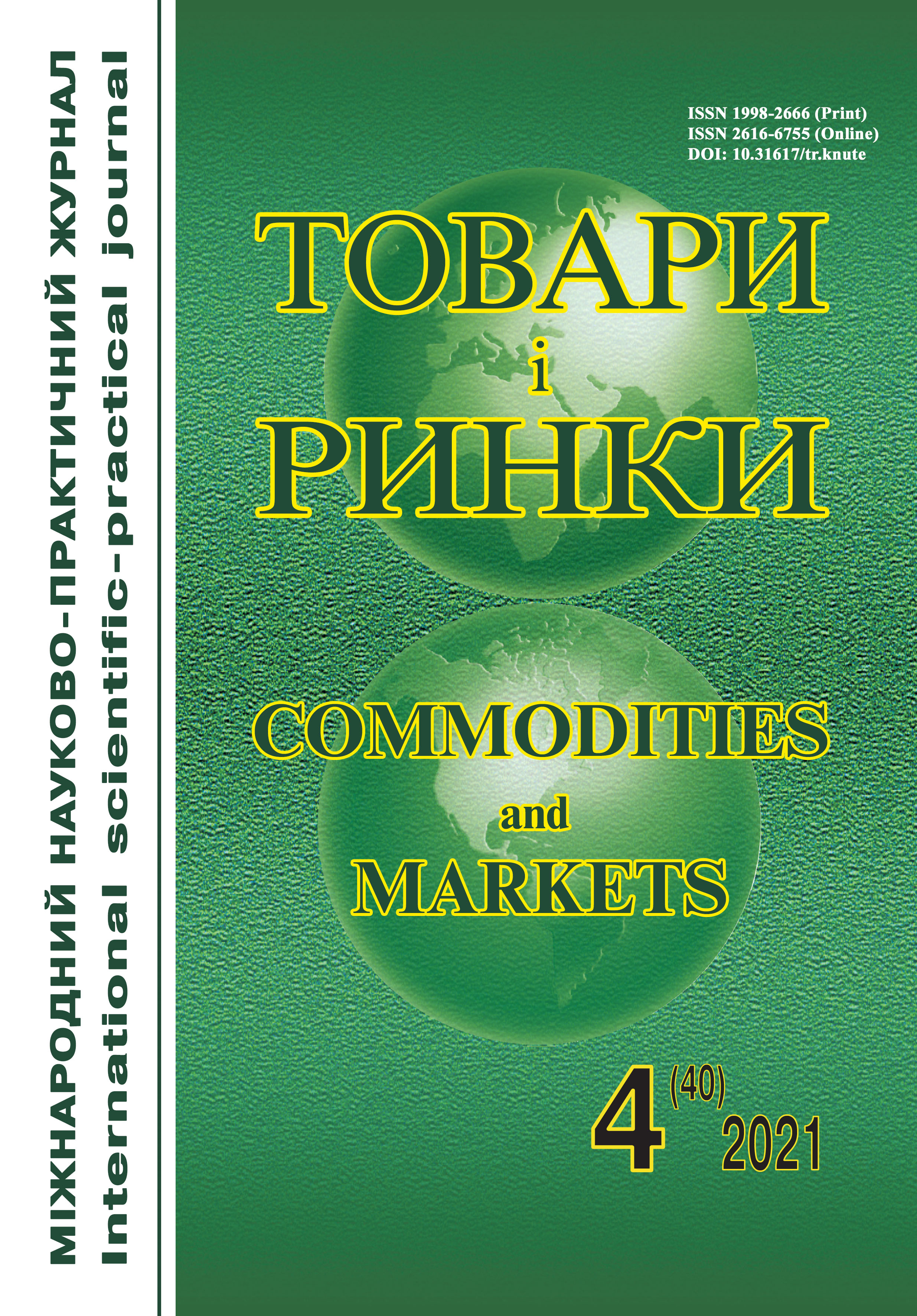Jelly food concentrate with encapsulated hibiscus extract
DOI:
https://doi.org/10.31617/tr.knute.2021(40)12Keywords:
food concentrates, swellable starch, hibiscus extract, encapsulation, jelly, rheological propertiesAbstract
Background. Taking into consideration the intense rhythm of life, the development of technologies for instant food products of increased nutritional value is urgent. Typically, food concentrates for desserts include fruit or fruit and berry fillings and require cooking to prepare ready-made meals. In this case, heat treatment of the mixture (boiling) negatively affects the thermolabile biologically active compounds.
The aim of the work was to develop a recipe for instant food jelly concentrates of increased nutritional value based on encapsulated powdery hibiscus extract.
Materials and methods. To encapsulate the aqueous-alcoholic extract of hibiscus and obtain a powdered semi-finished product, swelling potato starch was used. Rheological studies were carried out using a "REOTEST-2" rotational viscometer.
Results. In order to enrich food concentrates of instant kissel with biologically active substances, we studied a method for extracting dry hibiscus flowers with aqueous-alcoholic solutions of various concentrations. It was found that the extractivity and the transfer of polyphenolic compounds, including anthocyanins, to the extract are improved when a water-alcohol mixture with an ethyl alcohol concentration of 30 % is used as an extractant.
For the preparation of a powdery hibiscus extract, modified swelling starch was used, which has the property of swelling in cold water, which makes it possible not to subject the mixture to prolonged heat treatment for preparing a ready-made dish and to preserve the biologically active substances of the hibiscus extract. In addition, this starch is an effective solid carrier that plays a protective role for thermolabile vitamins and bioflavonoids. On the basis of experimental studies, formulations of instant jelly have been developed, which include fructose, powdered hibiscus extract, apple pectin and ascorbic acid.
The study of the rheological properties of semi-finished products based on hibiscus extract, as well as ready-made jelly, testifies to the receipt of a finished dessert with a delicate creamy consistency.
Conclusion. A method for obtaining a powdery encapsulated hibiscus extract based on swelling potato starch and a composition of a food jelly concentrate using this semi-finished product have been developed.
It was found that for the extraction of raw materials it is better to use a water-alcohol mixture with an ethanol content of 30 %, since most of the anthocyanins are converted into the extract under these conditions.
The developed semi-finished product of dry hibiscus extract can be used as a thickener, acidifier and colorant in recipes for food concentrates for instant dessert dishes. Due to the use of swelling starch, food concentrates of jelly do not need to be boiled, and the presence of vitamins, organic acids, flavonoids and especially anthocyanins in the hibiscus extract increases the nutritional value of the finished product.
References
Tehnologija ta laboratornyj praktykum kondyters’kyh vyrobiv i harchovyh koncentrativ [Technology and laboratory workshop of confectionery and food concentrates]. (2015). Dorokhovich, A. M., & Kovbasa, V. M. (Eds.). Kyi’v: Firma "INKOS" [in Ukrainian].
Metcalf, E. Hibiscus. (2021). MPH Medically Reviewed by Melinda Ratini. Retrieved from https://www.webmd.com/vitamins-and-supplements/hibiscus-uses-and-risks [in English].
Fresz, T., Nagy, E., Hilbert, A., & Tomcsanyi, J. (2014). The role of flavonoids in false positive digoxin assays caused by the consumption of hibiscus flower and rose hip tea. Int J Cardiol, 171 (2), 273-274 [in English].
Polishhuk, G., Gulak, E., Ramanauskas, R., & Sharahmatova, T. (2012). Sravnitel’nyj analiz razlichnyh sposobov poluchenija jekstrakta gibiskusa dlja ego ispol’zovanija v sostave morozhenogo, sorbeta i l’da [Comparative analysis of various methods for obtaining hibiscus extract for itsuse in the composition oficecream, sorbetandice]. Maisto chemija ir technologija. Mokslo darbai (Food chemistry and technology. Proceedings). Vol. 46, 2, 38-44 [in Russian].
Turchynjak, M. K. (2013). Efektyvnist’ zastosuvannja roslynnyh komponentiv u boroshnjanyh kondyters’kyh vyrobah [The effectiveness of plant components application in flour confectionery]. Obladnannja ta tehnologii’ harchovyh vyrobnyctv – Equipment and technologies of food production. Issue 30, 339-403 [in Ukrainian].
Peresichnyj, M. I., & Radchenko, M. V. (2013). Kysil’ jabluchno-garbuzovyj na osnovi lljanogo ta zernovogo vidvariv [Apple and pumpkin kyssil basedonflax and graindecoctions]. Patent UA, N82469 [in Ukrainian].
Rubanka, K. V., Terlec’ka, V. A., Kovbasa, V. M., Zinchenko, I. M. et al. (2016). Kysil’ "Miks" [Kyssil "Mix"]. Patent UA, N 113480 [in Ukrainian].
Chew, S. C., Tan, C. H., Pui, L. P., Chong, P. N, Gunasekaranv, B., & Lin, N. K. (2019). Encapsulation Technologies: A Tool for Functional Foods Development. International Journal of Innovative Technology and Exploring Engineering, 8 (5), 154-160 [in English].
Lysyj, O. V., Pichkur, V. Ja., Grabovs’ka, O. V., & Kovbasa, V. M. (2014). Doslidzhennja osnovnyh fizyko-himichnyh vlastyvostej nabuhajuchyh vydiv krohmalju [Investigation of the main physicochemical properties of swellable types of starch]. Naukovi praci ONAHT – Scientific works of ONAFT. Issue 46, Vol. 2, 148-152 [in Ukrainian].
Kovalenko, A. A., Grynchenko, O. O., Kovlajenko, A. A., Pyvovarov, P. P., Mostova, L. M., Neklesa, O. P. et al. (2010). Tehnologija desertiv z vykorystannjam stabilizacijnyh system na osnovi krohmalju [Technology of desserts using stabilization systems based on starch]. Harkiv: Harkivs’kyj derzhavnyj universytet harchuvannja ta torgivli [in Ukrainian].
Shpachuk, M., Tochona, A., Rubanka, K. V., & Terlec’ka, V. A. (2018). Doslidzhennja vplyvu vydu ekstragenta procesu ekstraguvannja na vyhid antocianiv z kvitiv Gibiskusu [Investigation of the influence of the type of extractant of the extraction process on the yield of anthocyanins from Hibiscus flowers.] Naukovi zdobutky molodi – vyrishennju problem harchuvannja ljudstva u XXI stolitti – Scientific achievements of young people – solving the problems of human nutrition in the XXI century: Proceeding sof the 84 International Scientific Conference Young Scientists, Postgraduate and Students. Kyi’v: НУХТ [in Ukrainian].
Gus’kov, K., Machihin, Ju., Machihin, S., & Lunin, L. (1970). Reologija pishhevyh mass [Rheology of food masses]. Moscow: Pishhevaja promyshlennost’ [in Russian].
Rao, M. A. (2014). Rheology of food gum and starch dispersions. Rheology of fluid, semisolid, and solid foods. Springer US [in English].



